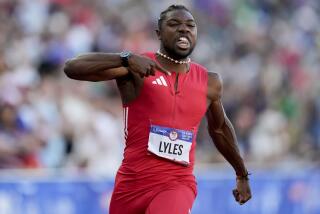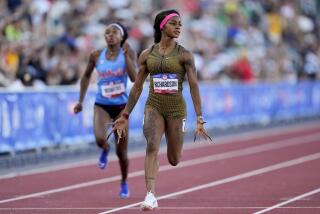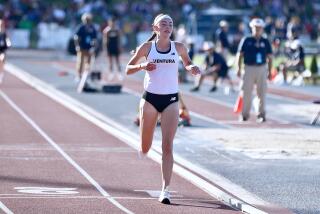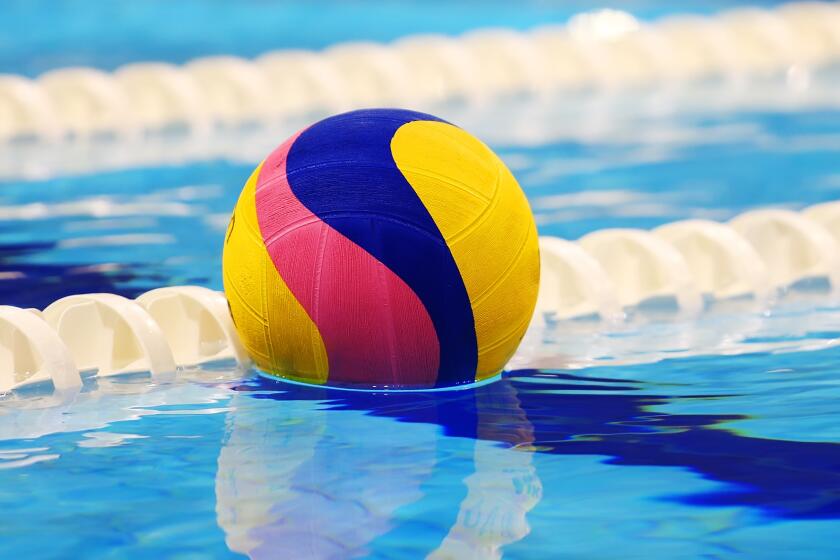O’Neill Tries to Get His Life Back on Track : Track and field: Runner expects to pass his test in the two-mile event at the Sunkist Invitational.
SAN DIEGO — It was a fleeting moment on the evening of June 3, 1989. Francis O’Neill, running for San Pasqual High School at the state track and field championships, found a reserve of adrenaline along the home stretch of the 1,600 meters and used it to power past the leader.
Seconds later, he broke the tape in 4:08.67.
Now, nearly two years later as O’Neill prepares for the two-mile at tonight’s Sunkist Invitational track meet at the Los Angeles Sports Arena, that 4:08.67 is still his best time in the 1,600 meters.
Something went wrong for one of the nation’s most promising distance runners coming out of high school. Although the University of Arizona beckoned, O’Neill didn’t have the grades to make the jump to a four-year college.
His running was sidetracked because, back in grade school, O’Neill sidestepped a reading problem that several years later was diagnosed as dyslexia. Though O’Neill could traverse any cross-country course, he kept stumbling over words. Dyslexia is a condition that jumbles letters on a page.
“I thought I could (overcome) it on my own,” O’Neill said. “And I didn’t even know I could get any help.”
Francis O’Neill kept his problem a secret.
Throughout high school, teachers labeled O’Neill lazy, unresponsive and lackadaisical. Teachers thought he had trouble reading because he didn’t try.
Even after San Pasqual Coach Will Wester spotted potential in O’Neill’s running style, the freshman didn’t seem to put forth an effort to hone his skill.
Sure, Wester convinced O’Neill to join the cross-country team (there was no need to try out; O’Neill already was that good), but whether he would show at practice was always a question.
Wester recalls one particular day just after O’Neill joined San Pasqual’s cross-country team. The runners gathered for an afternoon practice. Everyone was there except O’Neill.
The team followed its usual route, staying on the edge of roads in the south part of Escondido. There are bus stops along these streets, but rarely are there people waiting.
As the team jogged toward one of the stops, they encountered O’Neill and two buddies with surfboards under their arms.
“I told him, ‘Francis, you’re supposed to be out here with your team,’ ” Wester said.
O’Neill admits he reinforced his lackadaisical image on that day, but as Wester later discovered, it was more a fabricated image.
It wasn’t that O’Neill didn’t care about class work. He simply cared more about what he must look like to his peers and to his teachers. Projecting a rebellious image was a whole lot better than appearing unable to read.
“(We) are the same way,” Wester explained. “If you really try and still get an ‘F’ with a bunch of red marks all over your paper, you’re going to figure, ‘Why even try?’ You would shy away from something uncomfortable and unrewarding and find something that is rewarding.”
Early on, that something was surfing.
“I went surfing a lot before I started running,” O’Neill said. “But success helped me to start to get serious about running.”
Serious, indeed.
“He went from being that kid with his surfboard at the bus stop to never missing a practice his junior and senior years,” Wester said.
Suddenly, O’Neill presented a paradox. Here was a student very serious about improving athletically in an individual sport with little glory and little media attention, but he still seemed unattentive in class.
His running ability could earn him a scholarship, but his grades weren’t good enough to get him enrolled.
So Wester decided to push the issue. Why wouldn’t O’Neill study harder? Convinced that O’Neill was not a rebel, Wester asked him to get tested for learning disabilities.
It was only then, at the beginning of his senior year, that O’Neill learned the true nature of his condition.
The results pointed at dyslexia.
“It was an extreme learning disability,” Wester said. “Something that probably should have been caught in sixth or seventh grade.”
But the damage was done. Shying away from class work took its toll on O’Neill’s grade-point average. In fact, he had been on academic probation all along.
“There’s a good chance he might not have finished high school if it weren’t for his running,” Wester said.
Immediately after his victory at the state track meet in 1989, O’Neill was confronted by San Diego media.
He talked about how much he wanted to win the race, he told of his strategy and he spoke about how it felt to realize his dreams.
“How about college?” he was asked.
At that, O’Neill lost eye contact with reporters and began to speak softly. He said he still hoped a scholarship to Arizona would come.
Left unsaid was the unsettling suspicion that his GPA did not meet guidelines, even though he earned a 2.8 during his final three semesters.
O’Neill ended up at Long Beach City College.
He didn’t compete in either cross-country or track as a freshman, so he could have three years of eligibility at a university after he gets his Associate of Arts degree.
Last fall, then, was the first time O’Neill competed since the state track meet in 1989.
But unlike high school, O’Neill was not the top runner in the state. In fact, he was not even the top runner at Long Beach.
At the community college state cross-country championship meet, teammate Oscar Gonzales finished the four-mile Mt. San Antonio College course second overall with a time of 19:35. O’Neill came in sixth at 20:16.
In the long run, it might benefit O’Neill to be in someone’s shadow.
After all, as Ron Allice, Long Beach coach, pointed out, “Francis was never ‘over-run’ in high school.”
Now he’ll have someone pushing him, and someone else to help shoulder the pressure.
There’s already enough O’Neill must deal with, not the least of which will be proving that a year-and-a-half layoff didn’t take away his edge.
If living down the past isn’t enough, there are also expectations of the future.
“There’s no question in my mind Francis will be an Olympic-caliber athlete,” Wester said. “At this point, he’s only lacking the emotional stability of a runner at that level.”
The Olympics?
“Yeah,” O’Neill said. “It’s a goal in the back of my mind. I’m working toward it.”
O’Neill knows he can do the 1,600 (about a mile) in 4:08. The next step is to push himself to consistently run a mile in 4:03 or 4:04, Wester said.
“And then, toward the end of the season, he has to break the big one,” Wester continued. “That’s the natural progression. I would think he has to break four minutes if he wants to go to the Olympic trials (in 1992).”
Allice isn’t so sure if O’Neill is ready to even talk about running a sub-four-minute mile.
“He has the potential to run a sub-four-minute mile,” Allice said. “Whether he can this year or not, I don’t know. We’ll just have to see.”
But Allice did agree with Wester that O’Neill’s mental make-up will determine if he reaches that goal.
“He’s a very laid-back type of kid,” Allice said. “He has to learn to be aggressive, and once he gets that and once he increases the volume and quality of work, Francis will mature and develop. This is just a steppingstone to where he wants to be.”
Allice will be able to gauge O’Neill’s development tonight. After all, the Sunkist meet comes during the lull between college cross-country and track seasons.
Plus, O’Neill will be going up against guys like Doug Padilla, who is closing in on Emiel Putteman’s world record in the indoor two-mile (8:13.2). Last season, Padilla ran an 8:15.02, a U.S. record and second-fastest ever.
Also running will be Brian Diemer, the top-ranked U.S. 3,000-meter steeplechase runner in 1990, and Brian Abshire, owner of the fourth-fastest indoor 3,000-meter time (7:41.57).
“Francis should stay in contact with those people for as long a period as possible,” Allice said. “He’s not running for time, but to see how he can compete with these guys.”
Not a big test, but then again, tests on the track never have been big to O’Neill. Just easy.
The big tests will come in his psychology and biology classes about four months from now. O’Neill doesn’t appear daunted by the challenge.
“They’re the same classes as in high school,” he said. “Only harder.”
O’Neill said his grades are worthy of the NCAA now, and that while Arizona is still in the picture, he is also considering Cal Poly San Luis Obispo.
More to Read
Get our high school sports newsletter
Prep Rally is devoted to the SoCal high school sports experience, bringing you scores, stories and a behind-the-scenes look at what makes prep sports so popular.
You may occasionally receive promotional content from the Los Angeles Times.






